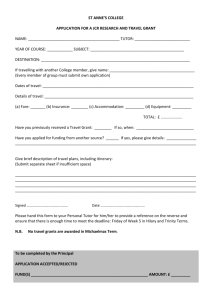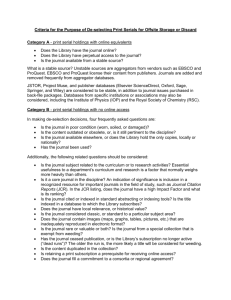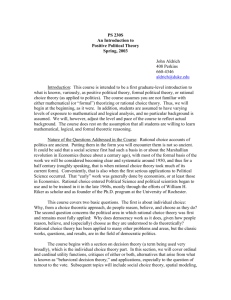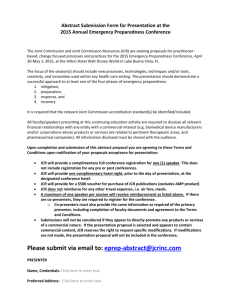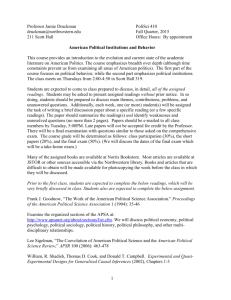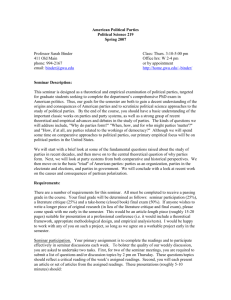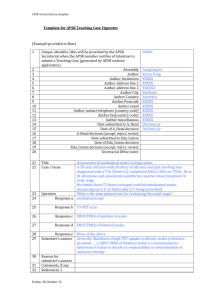POL 579 Topics in Formal Theory: International Relations Theory
advertisement
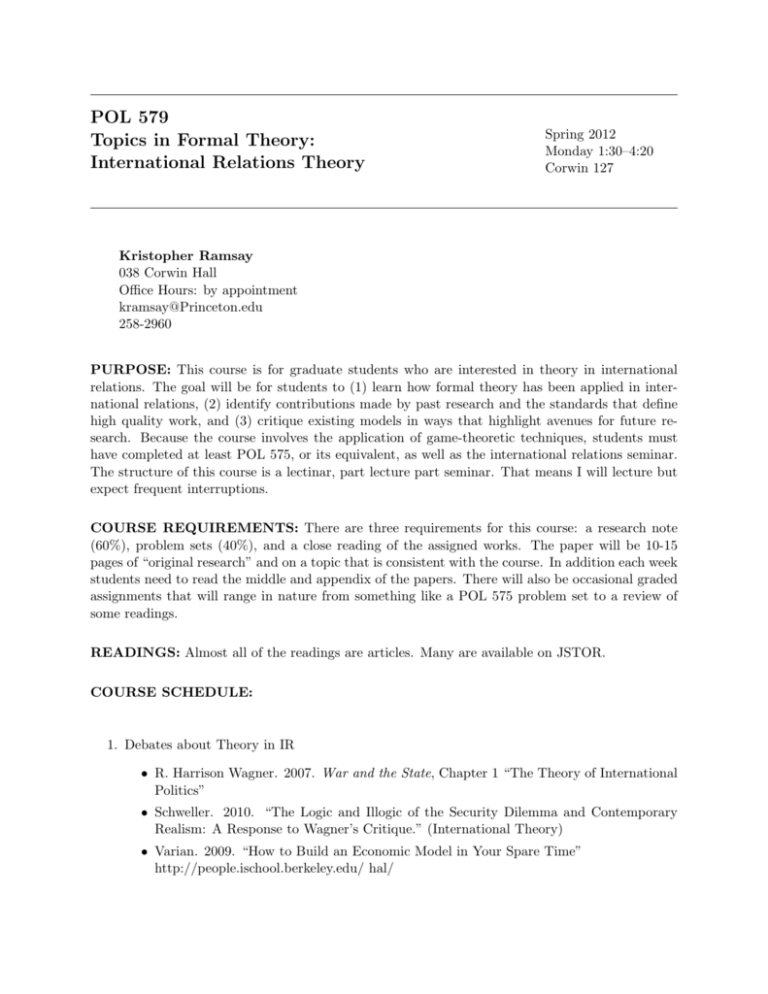
POL 579 Topics in Formal Theory: International Relations Theory Spring 2012 Monday 1:30–4:20 Corwin 127 Kristopher Ramsay 038 Corwin Hall Office Hours: by appointment kramsay@Princeton.edu 258-2960 PURPOSE: This course is for graduate students who are interested in theory in international relations. The goal will be for students to (1) learn how formal theory has been applied in international relations, (2) identify contributions made by past research and the standards that define high quality work, and (3) critique existing models in ways that highlight avenues for future research. Because the course involves the application of game-theoretic techniques, students must have completed at least POL 575, or its equivalent, as well as the international relations seminar. The structure of this course is a lectinar, part lecture part seminar. That means I will lecture but expect frequent interruptions. COURSE REQUIREMENTS: There are three requirements for this course: a research note (60%), problem sets (40%), and a close reading of the assigned works. The paper will be 10-15 pages of “original research” and on a topic that is consistent with the course. In addition each week students need to read the middle and appendix of the papers. There will also be occasional graded assignments that will range in nature from something like a POL 575 problem set to a review of some readings. READINGS: Almost all of the readings are articles. Many are available on JSTOR. COURSE SCHEDULE: 1. Debates about Theory in IR • R. Harrison Wagner. 2007. War and the State, Chapter 1 “The Theory of International Politics” • Schweller. 2010. “The Logic and Illogic of the Security Dilemma and Contemporary Realism: A Response to Wagner’s Critique.” (International Theory) • Varian. 2009. “How to Build an Economic Model in Your Spare Time” http://people.ischool.berkeley.edu/ hal/ 2. Bargaining and War • Waltz 1988. “The Origins of War In Neorealist Theory” (Jour. ID Hist.) • Fearon 1995. “Rationalist Explanations for War” (IO) • Fey and Ramsay 2011. “Uncertainty and Incentives in Crisis Bargaining.” (AJPS) 3. Commitment and War • Powell 2006 “War as a Commitment Problem” (IO) 4. How War Helps: Learning While Fighting and Enforceable Commitments • Powell 2004. “Bargaining and Learning While Fighting” (AJPS) • Langlois 2010. “Does the Principle of Convergence Really Hold?” typescript, GU • Leventoglu and Slantchev 2007. “The Armed Peace: A Punctuated Equilibrium Theory of War” (APSR) 5. Mutual Optimism and War • Blainey 1988. Causes of War chapter 3 “Dreams and Delusions of a Coming War” and pp. 122-124 • Fey and Ramsay 2007. “Mutual Optimism and War” (AJPS) • Slantchev and Tarar 2010. “Mutual Optimism as a Rationalist Explanation for War” (AJPS) 6. Strategic Deception • Crawford 2003. “Lying for Strategic Advantage” (AER) • Hendricks and McAfee 2006. “Feints” (JEMS) • Slantchev 2010. “Feigning Weakness” (IO) 7. Balance of Power/Threat • Walt 1985. “Alliance Formation and the Balance of World Power” (IS) • Niou and Ordershook 1990 “Stability in Anarchic International Systems” (APSR) • Garfinkle 2004. “Stable Alliance Formation in Distributional Conflict” (Euro. JPS) • Powell 1996. “Stability and the Distribution of Power” (WP) 8. Unipolarity • Wohlforth 1999. “The Stability of a Unipolar World” (IS) • Gowa and Ramsay. “Gulliver Untied” (Princeton) • Alt, Calvert, and Hume 1988. “Reputation and Hegemonic Stability” (APSR) 9. Institutions • Keohane 1982. “The Demand for International Regimes” (IO) • Voeten 2001. “Outside Options and the Logic of Security Council Action.” (APSR) • Milner and Rosendroff 2001. “The Optimal Design of International Trade Institutions” (IO) 2 • Jeheil, Molduvano, and Stacchetti. 1996. “How (not) to Sell Nuclear Weapons” (AER) 10. Spirals and War • Schelling 1960 .The Strategy of Conflict Chapter 9, “The Reciprocal Fear of Surprise Attack” • Jervis 1978. “Cooperation Under the Security Dilemma” (WP) • Kydd 1997. “Game Theory and the Spiral Model” (WP) • Baliga and Sjostrom 2004. “Arms Races and Negotiations” (RE Stud.) 11. Deterrence • Jervis 1979. “Review: Deterrence Theory Revisited” (WP) • Nalebuff 1991. “Rational Deterrence in a Imperfect World” (WP) • Powell 1989. “Nuclear Deterrence and the Strategy of Limited Retaliation.” (APSR) 12. Agency Problems in World Politics • Downs and Rocke 1994. “Conflict, Agency, and Gambling for Resurrection” (WP) • Hess and Orphanidies 1995. “War Politics” (AER) • BDM 2 S 2 1999. “An Institutional Explanation of the Democratic Peace” (APSR) 13. Audience Costs • Fearon 1994. “Domestic Political Audiences and the Escalation of International Disputes.” (APSR) • Ashworth and Ramsay. 2010 “Should Audiences Cost?” typescript, PU 14. Lawlessness and Governance • Spruyt 1994. The Sovereign State and its Competitors, Chapter 8 “The Victory of the Sovereign State.” • Dixit 2003. “On Models of Economic Governance.” (Econometrica) 15. Trade • Handout on international trade • Bagwell and Staiger 1999. “An Economic Theory of the GATT” (AER) • Grossman and Helpman 1994. “Protection for Sale” (AER) 16. Student Presentations (probably in May) Other Topics and Papers This incomplete list of references is a starting point to doing work on these topics. A. Models and Empirical Testing • Beck, Nathaniel, Jonathan N. Katz and Richard Tucker. 1998. “Taking Time Seriously: Time-Series-Cross-Section Analysis with a Binary Dependent Variable” (in Workshop). AJPS. 42(4). 3 • Beck, Neal, Gary King and Lengche Zeng. 2000. “Improving Quantitative Studies of International Conflict: A Conjecture.” APSR. 94(1). • Ramsay and Signorino. 2010. “A Statistical Model of the Ultimatum Game.” • Reed, William. 2000. “A Unified Statistical Model of Conflict Onset and Escalation.” AJPS. 44(1). • Signorino, Curtis S. 1999. “Strategic Interaction and the Statistical Analysis of International Conflict” APSR. • Signorino, Curtis S. 2000. “Theoretical Sources of Uncertainty in Discrete Choice Models” • Signorino, Curtis S. and Kuzey Yilmaz. 2003. “Strategic Misspecification in Regression Models.” AJPS. Forthcoming. • Smith, Alastair. 1999. “Testing Theories of Strategic Choice: The Example of Crisis Escalation” (in Workshop). AJPS. 43(4). B. Balance of Power • Alt, James, Randall Calvert, and Brian Humes. 1988. “Reputation and Hegemonic Stability: A Game Theoretic Analysis” APSR 82(2). • Brito, Dagobert and Michael Intriligator. 1996. “Proliferation and the probability of war: a cardinality theorem”. JCR. Vol. 40 no. 1. • Niou, Emerson and Peter Ordeshook. 1987. “Preventive War and the Balance of Power.” JCR. 31(3). • Niou, Emerson and Peter Ordeshook. 1990. “Stability in Anarchic International Systems.” APSR. 84(4). • Powell, Robert. 1996. “Stability and the Distribution of Power”. World Politics. • Wagner, Harrison. 1986. “The Theory of Games and Balance of Power.” World Politics. 38(4). • Wagner, Harrison. 1994. “Peace, War, and the Balance of Power.” APSR. 88(3). C. Alliances • Fang and Ramsay. 2010. “Outside Options and Burden-sharing in Nonbinding Alliances” PRQ 63:1, 188–202. • Fink, Humes and Schwebach. 1997. “The Size Principal and the Strategic Basis of an Alliance.” II. 22(3). • Gartner, Scott and Randolph Siverson. 1996. “War expansion and war outcome”. JCR. Vol. 40 no.1. • Morrow, James. 1994. “Alliances, Credibility, and Peacetime Costs.” JCR. 38(2):270–97. • Niou, Emerson and Peter Ordeshook. 1994. “Alliances in Anarchic International Systems.” ISQ. 38(2). 4 • Signorino, Curtis S. and Jeffrey M. Ritter. 1999. “Tau-b or Not Tau-b: Measuring the Similarity of Foreign Policy Positions.” ISQ. 43(1). • Smith, Alastair. 1995. “Alliance Formation and War.” ISQ. 39(4). • Smith, Alastair. 1996. “To Intervene or Not to Intervene.” JCR. 40(1). • Smith, Alastair. 1998. “Extended deterrence and alliance formation”. II. Vol. 24, no. 4. (Note: Be careful of typos.) • Sorokin, Gerald. 1994. “Alliance formation and general deterrence: a game theoretic model and the case of Israel.” JCR. Vol. 38, no. 2. D. Power Transition • Kim, Woosang and James Morrow. 1992. “When Do Power Shifts Lead to War?” AJPS. 36(4). • Organski, Kenneth and Jacek Kugler. 1993. “The Power Transition.” in Midlarsky, ed., Handbook of War Studies. • Powell, Robert. 1996. “Uncertainty, Shifting Power, and Appeasement.” APSR. 90(4):749– 764. • Powell, Robert. 1999. Chapter 4, “Bargaining in the Shadow of Shifting Power.” In the Shadow of Power. Princeton. E. Deterrence and Arms Races • Fearon, James. 1994. “Signaling versus the Balance of Power and Interests.” JCR. 38(2). • Kilgour, Marc and Frank C. Zagare. 1991. “Credibility, Uncertainty, and Deterrence.” AJPS. 35(2). • Nalebuff. 1986. “Rational Deterrence in an Imperfect World.” World Politics. 43(April). • Signorino, Curtis S. and Ahmer Tarar. 2000. “A Unified Theory and Test of Extended Immediate Deterrence.” • Zagare, Frank C. 1990. “Rationality and Deterrence.” World Politics. 42(2). • Zagare Frank C. and Marc Kilgour. 1993. “Asymmetric Deterrence.” ISQ. 37(1). • Zagare, Frank C. and D. Marc Kilgour. 1995. “Assessing Competing Defense Postures: The Strategic Implications of ‘Flexible Response’.” World Politics. 47(3). • Kydd, Andrew. 1997. “Game theory and the spiral model”. World Politics. • Kydd, Andrew. 2000. “Trust, reassurance, and cooperation”. IO. 54(2). • Baliga and Sjostrom. 2008. “Strategic Ambiguity and Arms Proliferation.” JPE 116:6, 10231057. 5 F. Bargaining and War • Banks, Jeff. 1990. “Equilibrium Behavior in Crisis Bargaining Games.” AJPS. 34(3). • Slantchev, Branislav L. 2003. “The Power to Hurt: Costly Conflict with Completely Informed States” American Political Science Review, Vol. 47, No. 1. (March, 2003), pp. 123-135. • Fearon, James. 1995. “Rationalist Explanations for War.” IO. 49(3). • Fey and Ramsay. forth. “Uncertainty and Incentives in Crisis Bargaining.” AJPS • Fey and Ramsay. 2009. “Mechanism Design Goes to War.” RED. 13:3 233–250. • Sartori, Anne. 2002. “A Reputational Theory of Communication in Disputes.” IO. 56(1). • Gartzke, Erik. Summer 1999. “War is the Error Term”. IO. • Morrow, James. 1989. “Capabilities, Uncertainty, and Resolve.” AJPS. 33(4). • Powell, Robert. 1987. “Crisis Bargaining, Escalation, and MAD.” APSR. 81(3). • Powell, Robert. 1988. “Nuclear Brinkmanship with Two-Sided Incomplete Information.” APSR. 82(March):155–178. • Wagner, R. Harrison. 2000. “Bargaining and War”. AJPS. Vol. 44, no. 3. • Slantchev, Branislav. 2003. “Power to Hurt: Costly COnflict with Completely Informed States.” APSR 91:1, 123–133. G. Cooperation • Axelrod, Robert. 1986. “An Evolutionary Approach to Norms.” APSR. 80(4). • Bendor, Jonathan and Mookherjee. 1990. “Norms, Third Party Sanctions, and Cooperation.” JLEO. 6(1). • Bendor, Jonathan. 1993. “Uncertainty and the Evolution of Cooperation.” JCR. 37(4). • Cederman, Lars-Erik. 2001. “Modeling the Democratic Peace as a Kantian Selection Process.” JCR. 45(4). • Langlois, Catherine and Jean-Pierre Langlois. 1999. “Behavioral issues of rationality in international interaction: a game theoretic analysis”. JCR. 43(5). • Signorino. Curtis S. 1996. “Simulating International Cooperation Under Uncertainty.” JCR. 40(1). • Stone, Randall. 2001. “The Use and Abuse of Game Theory in International Relations: The Theory of Moves.” JCR. 45(2). See also response by Brams. H. Institutional Design • Morrow, James. 1997. “When do relative gains impede trade?”. JCR. 41(1). 6 • Schneider, Gerald and Lars-Erik Cederman. 1994. “The change of tide in political cooperation: a limited information model of European integration”. II. Summer. • Voeten, Erik. 2001. “Outside Options and the Logic of Security Council Action.” American Political Science Review. 95(4). • Milner and Rosendroff 2001. “The Optimal Design of International Trade Institutions” IO I. Domestic Politics, pt I • Iida, Keisuke. 1993. “When and How Do Domestic Constraints Matter?” JCR. 37(3). • Mo, Jongryn. 1994. “Two-level Games with Endogenous Domestic Coalitions.” JCR. 38(3). • Mo, Jongryn. 1995. “Domestic Institutions and International Bargaining: The Role of Agent Veto in Two-Level Games.” APSR. 89(4). • Tarar, Ahmer. 2001. “International Bargaining with Two-Sided Domestic Constraints.” JCR. 45(3). J. Domestic Politics, pt II • Downs, George and David M. Rocke. 1994. “Conflict, Agency, and Gambling for Resurrection.” AJPS. 38(2). • Fearon, James. 1994. “Domestic Political Audiences and the Escalation of International Disputes.” APSR. 88(3). • Fearon, James. 1997. “Signaling foreign policy interests: tying hands versus sinking costs”. JCR. Vol. 41, no.1. i • Jackson, Matthew and Massimo Morelli. 2007. “Political Bias and War.” AER 97:4 • Kilgour, Marc. 1991. “Domestic Political Structure and War Behavior.” JCR. 35(2). • Morgan, T. Clifton and Valerie Campbell. 1991. “Structure, Decisional Constraints, and War.” JCR. • Richards, Diana, T. Clifton Morgan, Rick Wilson, Valerie Schebach, and Gary Young. 1993. “Good Times, Bad Times, and the Diversionary Use of Force: a tale of some not-so-free agents”. JCR. Vol. 37, no. 3. • Baliga, Lucca and Sjostrom. forth. “Domestic Political Survival and International Conflict: Is Democracy Good for Peace. REStud • Ramsay. 2004. “Political at the Water’s Edge.” JCR. 48:4, 459–613. • Ashworth and Ramsay. 2010. “Should Audiences Cost?” • Slantchev. 2006. “Politicians, the Media, and Domestic Audience Costs.” ISQ 50:2, pp. 445-477 7 • Schultz, Kenneth. 1998. “Domestic opposition and signaling in international crises”. APSR. 92(4). • Smith, Alastair. 1998. “International Crises and Domestic Politics”. APSR. 92(3). • • Goemans and Fey 2009. “Risky but Rational: War as an Institutionally Induced Gamble” JOP K. Domestic Politics, pt III • Bueno de Mesquita, Bruce and Randolph Silverson. “War and the survival of political leaders: a comparative study of regime types and political accountability”. APSR. 89(4). • Bueno de Mesquita, Bruce, James Morrow, Randolph Silverson, and Alastair Smith. 1999. “An institutional explanation of the democratic peace”. APSR. 93(4). • Maoz, Zeev and Bruce Russett. 1992. “Normative and Structural Causes of the Democratic Peace.” APSR. 87(3):624–38. • Schultz, Kenneth. 1999. “Do Democratic Institutions Constrain or Inform? Contrasting Two Institutional Perspectives on Democracy and War”. IO. Spring. L. International Political Economy • Downs, George, David Rocke, and Peter Barsoom. 1998. IO. Spring. • Gawande, Kishor and Wendy Hansen. 1999. “Retaliation, Bargaining, and the Pursuit of ‘Free and Fair’ Trade”. IO. Winter. • Lohmann, Susanne. 1997. “Linkage Politics”. JCR. 41(1). • Milner, Helen and Peter Rosendorf. 1997. “Domestic politics and international trade negotiations: elections and divided government as constraints on trade liberalization”. JCR. 41(1). • Rosendorff, B. Peter and Helen Milner. 2001. “The Optimal Design of International Trade Institutions: Uncertainty and Escape.” IO. 55(4). • Mansfield, Edward D., Helen V. Milner, and B. Peter Rosendorff. 2002. “Why Democracies Cooperate More: Electoral Control and International Trade Agreements.” IO. 56(3). • Pahre, Robert. 1998. “Reactions and reciprocity: tariffs and trade liberalization from 1815 to 1914”. JCR. 42(4). • Reuveny, Rafael and John Maxwell. 1998. “Free trade and arms races”. JCR. 42(6). M. Diplomacy and Mediation • Kurizaki, Shuhei. 2007. “Efficient Secrecy: Public versus Private Threats in Crisis Diplomacy.” American Political Science Review 101, 3 (August) 8 • Ramsay, Kristopher W. Nd. “Cheap Talk Diplomacy, Voluntary Negotiations, and Variable Bargaining Power.” ISQ forthcoming • Kydd, Andrew. 2001. “Which Side are You On?” AJPS • Fey, Mark and Kristopher W. Ramsay. 2010. “When is Shuttle Diplomacy Worth the Commute?” WP N. War Termination • Slantchev, Branislav L. 2003. “The Principle of Convergence in Wartime Negotiations” American Political Science Review, Vol. 47, No. 4. (December, 2003), pp. 621-632. • Slantchev, Branislav L. 2004. “How Initiators End Their Wars: The Duration of Warfare and the Terms of Peace” American Journal of Political Science, Vol. 48, No. 4. (October, 2004), pp. 813-829. • Filson, Darren and Suzanne Werner. 2004. “Bargaining and Fighting.” AJPS • Filson, Darren and Suzanne Werner. 2002. “A Bargaining Model of War and Peace” AJPS • Powell, Robert. 2007. “Bargaining and Learning while Fighting” AJPS O. Commitment Problems and War • Fearon, James. 1998. “Bargaining, Enforcement, and International Cooperation”. IO. 52(2). • Fearon, James. “Bargaining over Objects that Influence Future Bargaining Power.” • Schwartz and Sonin. 2008. “A Theory of Brinksmanship, Conflict, and Commitments.” JLEO 24:1, 163–183. • Powell, Robert. 2006. “War as a Commitment Problem” IO 60:1 (Winter) • Schultz. Kenneth. 2010. “The Enforcement Problem in Coercive Bargaining: Interstate Conflict over Rebel Support in Civil Wars” IO, 64:2 (Spring) P. Optimism and War • Wittman. Donald. 1979. “How a War Ends: a rational model approach” JCR • Fey, Mark and Kristopher W. Ramsay. 2007. “Mutual Optimism and War” AJPS • Fey, Mark and Kristopher W. Ramsay. 2010. “Mutual Optimism and Unilateral War” Princeton • Slantchev and Tarar. forth. “Mutual Optimism as a Rationalist Explanation for War.” AJPS • Yildiz, Muhamet. 2003. “Bargaining without a Common Prior–An Immediate Agreement Theorem.” Econometrica 71:3, 793–811. • Alastair Smith and Alan Stam. 2004. “Bargaining and the Nature of War” JCR 9 Q. Terrorism and Counter-terrorism • Baliga and Sjostrom. 2010. “The Strategy of Manipulating Conflict” Northwestern. • Bueno de Mesquitea, Ethan. 2005. “The Quality of Terror.” AJPS 49:3, 515–530 • Bueno de Mesquitea, Ethan. forth “Regime Change and Revelutionary Entrepeneurs.” APSR • Baliga and Ely. “Torture” Northwestern R. Dynamic Models of War • Hess, G.D. 1995. “An Introduction to Lewis Fry Richardson and His Mathematical Theory of War and Peace.” Conflict Management and Peace Science 14:1, 77–113. • Yared. 2010. “A Dymanic Theory of War and Peace” JET 145:5, 1921–1950. 10

